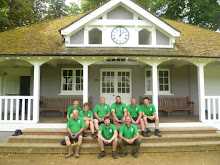 |
| The Canes Mark The Spot |
Yesterday Ali and Graham spent the afternoon preparing two small areas of lawn for the planting of five trees, Crab Apple 'Evereste'.
 |
| Making A Tree Circle |
 |
| Digging The Holes |
Having carefully measured out the exact spot for each tree to be planted five tree circles, measuring 1 metre in diameter, were dug out. The turf was removed and the soil placed on large boards to the side of each circle ready for back filling around the trees.
 |
| Waiting For The Trees |
 |
| The Trees Delivered |
Today the trees arrived, the five crab apple,
Malus 'Evereste', along seven other trees that are to planted in the college grounds. Varying in sizes, the largest being in a 200 litre root bag, the smallest 45 litres, all having to be unloaded from the side of the delivery lorry and carried in to the college.
The seven trees are as follows:
Quercus castaneifolia (Chestnut-leaved Oak Tree), 2 x
Quercus robur (Common Oak, English Oak), 3 x
Platanus orientalis Minaret (Oriental Plane),
Taxodium distichum Feathered (Swamp Cypress). These trees have been purchased from Barcham Trees, Ely, Cambridgeshire
www.barcham.co.uk
 |
| Careful Not To Drop It! |
 |
| The New Trees |
 |
| Measure And Re-Measure |
The five crab apples trees were loaded on to the trailer and driven over to where they were to be planted. Measuring and re-measuring, and making the holes deeper, each tree, having had the root bag removed, was carefully lowered in to place. Holding the tree upright and straight the soil, with an added mix of leaf mould, was back filled in to the remainder of the hole and gently firmed in.
 |
| 'Is It Straight?' |
 |
| Adding A Tree Stake |
To prevent wind rock and movement, the winter has been rather windy so far, each tree was tied to a wooden stake for support. Finally the trees were given a good drink of water.
These Crab Apple trees have wonderful orange fruit at this time of year and, come the spring, will be covered in a mass of cup-shaped, white flowers, something to look forward to.
 |
| The Orange Fruit Of Crab Apple 'Evereste' |
 |
| Ali And The 'Evereste' |



















































